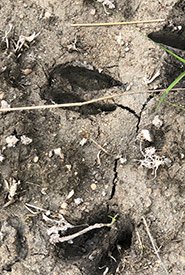Champions of conservation: landowners’ commitment to nature

From left to right: Clint Blyth, Anja Sorensen (NCC staff) and Jody Blyth (Photo by Emily Schulte/NCC staff)
Landowners Clint and Jody Blyth made the 2023 Pipestone Creek Bioblitz (held on June 13) possible (read more about the event in part one of this blog). It was a great opportunity for people to learn about conservation and the Blyths’ partnership with the Nature Conservancy of Canada (NCC). I was lucky to interview Clint and NCC’s Levi Boutin, stewardship coordinator, and some of the people that volunteered their time and expertise to make the bioblitz happen.
Clint and Jody decided to do a conservation agreement (also known as an easement) on their property because they wanted to ensure it would be protected forever for the benefit of conservation. A conservation agreement is a set of mutually agreed-upon restrictions placed on a piece of land. It is compiled into a legal document and registered to the land title, meaning that even if the land is sold, the agreement will still be in effect. They felt it was important to realize the value of the property beyond its monetary value, and make sure the landscape remains in its natural state. Both of their sons were on board with the idea and supported their decision, so they thought why not them? Clint mentioned that agreements might not work for everybody but it's a good fit for where he and Jody are in their life right now. Holding the bioblitz on their land was an opportunity for them to raise awareness of the importance of biodiversity, inspire a sense of wonder, and foster a connection between people and the natural world, perhaps encouraging others to explore land conservation options too.

Blyth property sign at the entrance (Photo by Emily Schulte/NCC staff)
The Blyths had big dreams when envisioning their conservation agreement project, where a cattle grazing operation could support habitat connectivity for wildlife in a natural landscape. In 2007, they came to southeastern Saskatchewan to find affordable land that could properly support cattle and their conservation goals. Before moving, they lived in southern Alberta where Clint was a geologist and Jody ran their small cattle feed lot. Their old property was surrounded by protected land, so they had already seen the positive impact that conservation land has, before moving to Saskatchewan. Clint was proud to tell me that their old property in Alberta is now part of the Wilder Institute and is being used for conservation. Today, the Blyths have a total of three conservation agreements, including the one with NCC, on their Saskatchewan property.

Deer tracks (Photo by Emily Schulte/NCC staff)
Growing up, Levi went camping with his family every summer and fell in love with nature through those trips; that’s how he knew he wanted to do something in the environmental field. He joined NCC because he feels it is contributing to conservation in an effective way in the Prairies. What draws him to plant ecology is that each plant species has a unique relationship with all the other species and environmental conditions around it. Levi can tell a lot about the conditions and ecological health of an area just by looking at the composition of the plants in that location.
He was excited to join the bioblitz because Pipestone Creek is very different from the dry grasslands of southwest and southcentral Saskatchewan where he normally works. Levi liked seeing so many different colours of flowers and all the lush green vegetation there. His favourite plant he saw on the trip was a two-leaved Solomon’s-seal (wild-lily-of-the-valley), and he said that the biggest highlight of his job is being able to spend a day in a conserved area like this one.
A big thanks to Clint and Jody for welcoming people to conduct a bioblitz on their property. Their conservation agreement and land management practices will help prevent habitat loss, protect endangered species and ensure the long-term conservation of this remarkable area.

